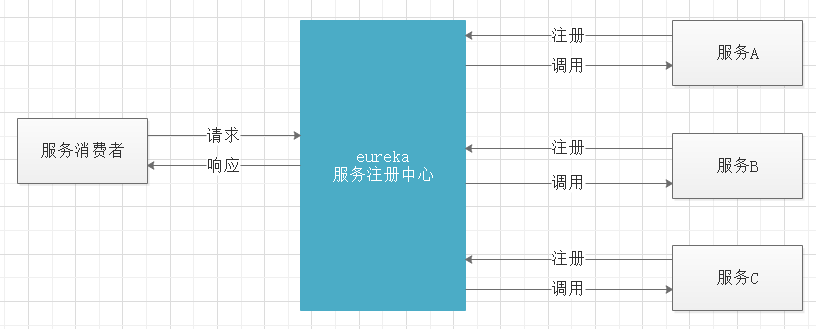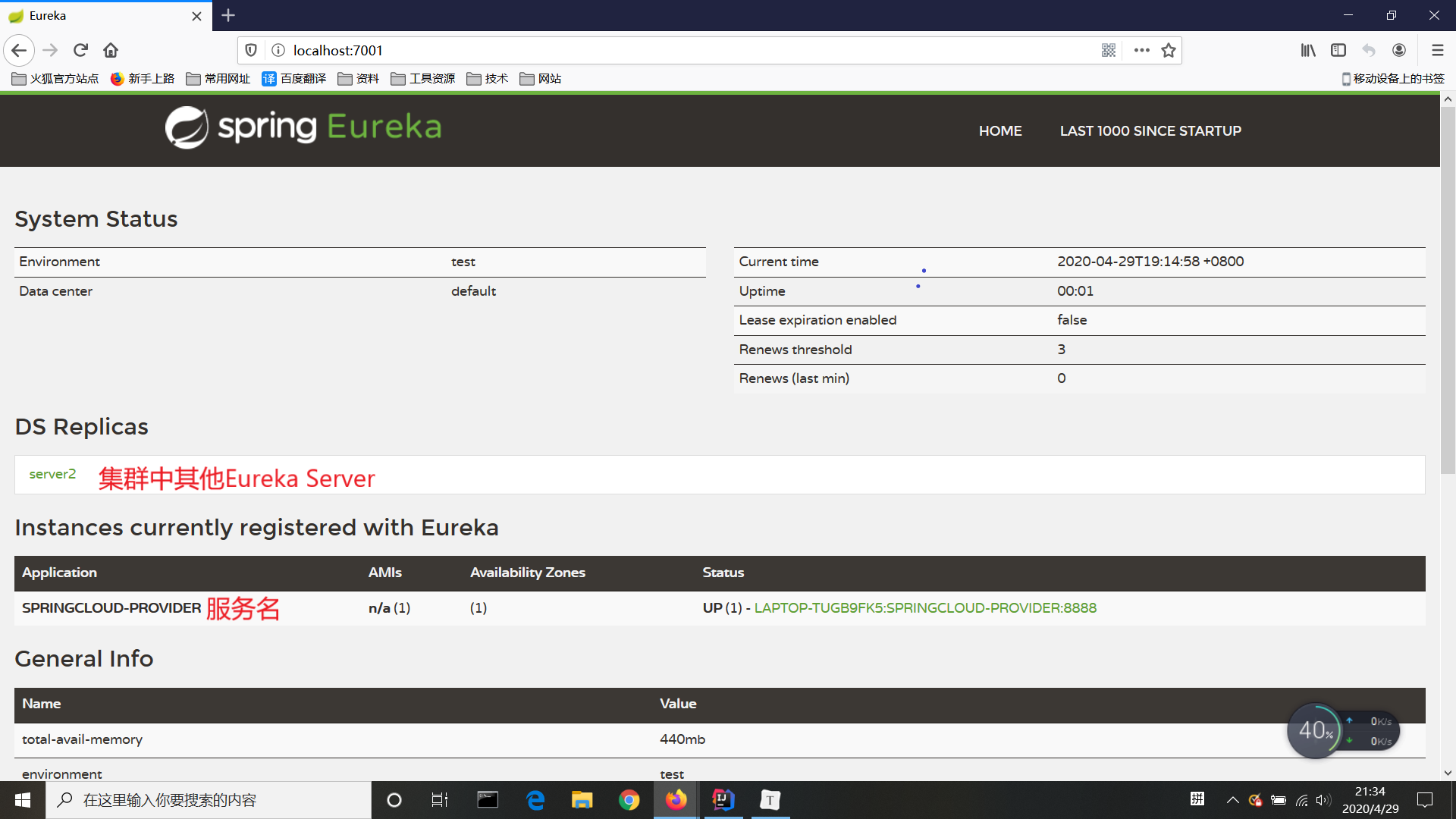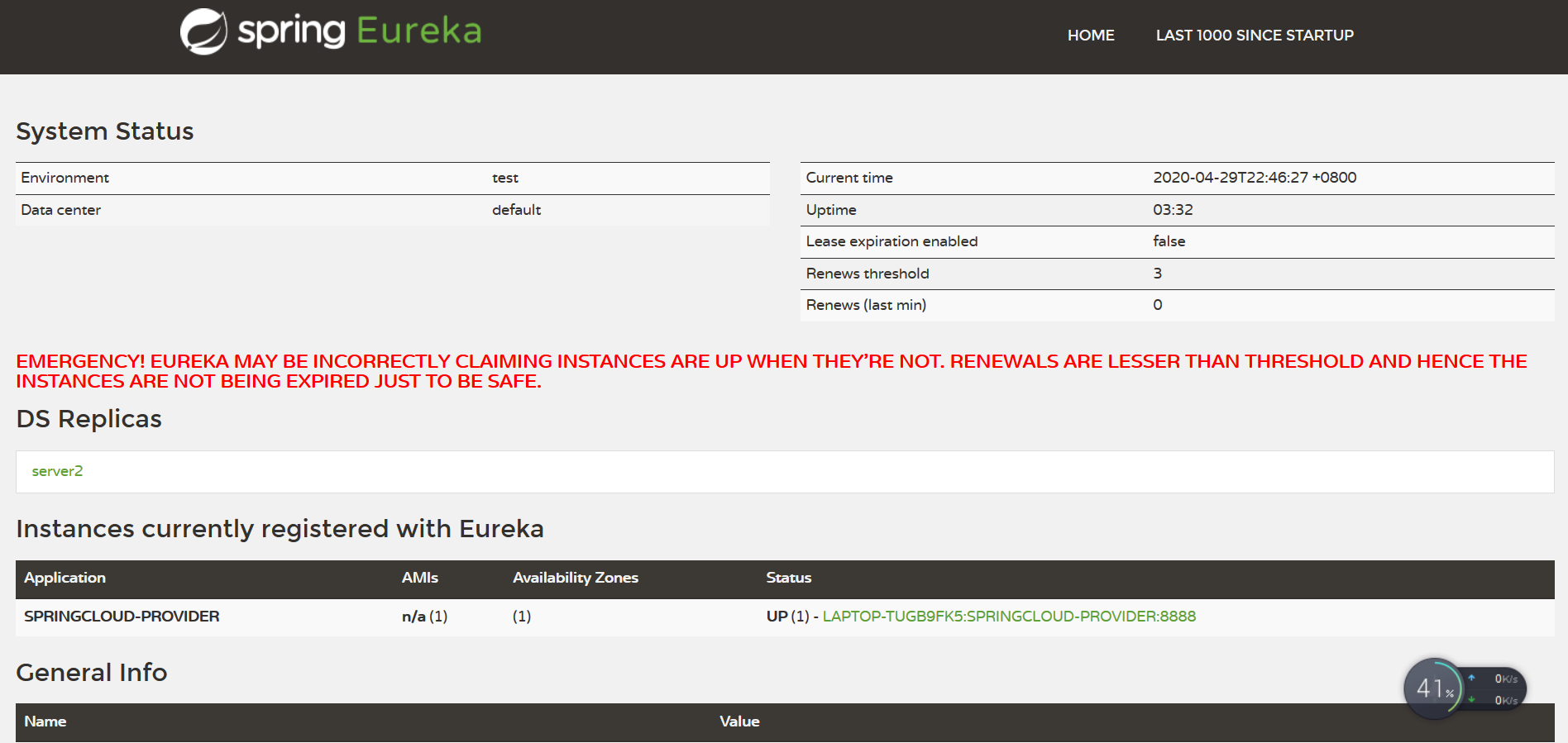SpringCloud(三):Eureka注册与发现
2021-01-24 10:14
标签:ring uid 导致 alibaba 生产 public emc 帮助 frame 在微服务架构里说过微服务架构有四大问题,其一就是 这么多服务,如何管理? 而Eureka就是Netflix提供给我们来管理众多服务的。 Eureka是一个基于REST(Representational State Transfer)的服务,主要用于AWS云中定位服务,以实现中间层服务器的负载平衡和故障转移。 在Netflix,Eureka除了在中端负载平衡中发挥关键作用外,还用于以下目的。 为了帮助Netflix Asgard—一个使云部署更容易的开源服 在遇到问题时快速回滚版本,避免重新启动100个实例,这可能需要很长时间。 在滚动推送中,为了避免在出现问题时向所有实例传播新版本。 为了我们的cassandra部署,将实例从流量中取出进行维护。 为了我们的memcached缓存服务来识别环中的节点列表。 出于各种其他原因,用于携带有关服务的其他特定于应用程序的元数据。 添加 eureka-server 依赖 添加配置 在启动类使用 在之前的服务提供者的基础上,添加 eureka 依赖 添加配置 在启动类添加 添加配置 通过服务名调用服务者 创建启动类,添加 访问 http://localhost:7001/ 1.创建多一个Eureka Server,依赖和启动类和之前一样,只需更改配置中的defaultZone 把之前的Eureka Server的配置中的defaultZone也改成 2.更改服务者和消费者的配置中的defaultZone 默认情况下,如果 Eureka Server 在一定的 90s 内没有接收到某个微服务实例的心跳,会注销该实例。但是在微服务架构下服务之间通常都是跨进程调用,网络通信往往会面临着各种问题,比如微服务状态正常,网络分区故障,导致此实例被注销。 固定时间内大量实例被注销,可能会严重威胁整个微服务架构的可用性。为了解决这个问题,Eureka 开发了自我保护机制,那么什么是自我保护机制呢? Eureka Server 在运行期间会去统计心跳失败比例在 15 分钟之内是否低于 85%,如果低于 85%,Eureka Server 即会进入自我保护机制。 Eureka Server 触发自我保护机制后,页面会出现提示: Eureka Server 进入自我保护机制,会出现以下几种情况: Eureka 不再从注册列表中移除因为长时间没收到心跳而应该过期的服务 Eureka 仍然能够接受新服务的注册和查询请求,但是不会被同步到其它节点上(即保证当前节点依然可用) 当网络稳定时,当前实例新的注册信息会被同步到其它节点中 Eureka 自我保护机制是为了防止误杀服务而提供的一个机制。当个别客户端出现心跳失联时,则认为是客户端的问题,剔除掉客户端;当 Eureka 捕获到大量的心跳失败时,则认为可能是网络问题,进入自我保护机制;当客户端心跳恢复时,Eureka 会自动退出自我保护机制。 如果在保护期内刚好这个服务提供者非正常下线了,此时服务消费者就会拿到一个无效的服务实例,即会调用失败。对于这个问题需要服务消费者端要有一些容错机制,如重试,断路器等。 通过在 Eureka Server 配置如下参数,开启或者关闭保护机制,生产环境建议打开: 我的个人博客站 SpringCloud(三):Eureka注册与发现 标签:ring uid 导致 alibaba 生产 public emc 帮助 frame 原文地址:https://www.cnblogs.com/gaofei200/p/12865974.htmlEureka简介

Eureka使用实例
1. 创建Eureka Server
dependency>
groupId>org.springframework.cloudgroupId>
artifactId>spring-cloud-starter-netflix-eureka-serverartifactId>
version>1.4.7.RELEASEversion>
dependency>
server:
port: 7001
eureka:
instance:
hostname: server1
client:
register-with-eureka: false # 是否将自己注册到Eureka Server, 默认为true
fetch-registry: false # 是否从Eureka Server获取注册信息,默认为true
service-url:
defaultZone: http://localhost:7001/eureka/
@EnableEurekaServer注解@SpringBootApplication
@MapperScan("com.example.springcloud.mapper")
@EnableEurekaServer //声明该应用为Eureka Server
public class Eureka7001 {
public static void main(String[] args) {
SpringApplication.run(Eureka7001.class, args);
}
}2.创建Eureka Client(即服务提供者)
dependency>
groupId>org.springframework.cloudgroupId>
artifactId>spring-cloud-starter-netflix-eureka-clientartifactId>
version>1.4.7.RELEASEversion>
dependency>
server:
port: 8888
spring:
application:
name: springcloud-provider #注册中心中的服务名
datasource:
driver-class-name: com.mysql.jdbc.Driver
url: jdbc:mysql://localhost:3306/db01?useUnicode=true&characterEncoding=utf-8&allowMultiQueries=true&serverTimezone=Asia/Shanghai
username: root
password: "123456"
type: com.alibaba.druid.pool.DruidDataSource
eureka:
client:
service-url:
defaultZone: http://localhost:7001/eureka/ #对应Eureka Server的defaultZone@EnableEurekaClient注解@SpringBootApplication
@EnableEurekaClient //声明该应用为Eureka Client
public class Provider_8888 {
public static void main(String[] args) {
SpringApplication.run(Provider_8888.class,args);
}
}
3.消费者
server:
port: 80
eureka:
client:
register-with-eureka: false
service-url:
defaultZone: http://localhost:7001/eureka/ #对应Eureka Server的defaultZone
package com.example.springcloud.controller;
import com.example.springcloud.domain.User;
import org.springframework.beans.factory.annotation.Autowired;
import org.springframework.web.bind.annotation.PathVariable;
import org.springframework.web.bind.annotation.RequestMapping;
import org.springframework.web.bind.annotation.RestController;
import org.springframework.web.client.RestTemplate;
import java.util.List;
@RestController
@RequestMapping("/consumer")
public class IndexController {
@Autowired
private RestTemplate restTemplate;
// “http://服务名/[controller类上的RequestMapping]”,服务名是服务者配置里的spring.application.name
// 如果服务提供者controller类上不加RequestMapping,[]里的路径可去掉
private static final String URL = "http://SPRINGCLOUD-PROVIDER/user/";
@RequestMapping("/user/{id}")
public User getUserById(@PathVariable("id")Integer id) {
return restTemplate.getForObject(URL+id, User.class);
}
@RequestMapping("/user/list")
public List@EnableEurekaClient注解@SpringBootApplication(exclude = {DataSourceAutoConfiguration.class})
@EnableEurekaClient //声明该应用为Eureka Client
public class Consumer {
public static void main(String[] args) {
SpringApplication.run(Consumer.class, args);
}
}

Eureka集群
server:
port: 7002
eureka:
instance:
hostname: server2 #在注册中心中的Eureka Server名
client:
register-with-eureka: false # 是否将自己注册到Eureka Server, 默认为true
fetch-registry: false # 是否从Eureka Server获取注册信息,默认为true
service-url:
defaultZone: http://localhost:7001/eureka/ #对集群中其他Eureka Server,多个用逗号分开
server:
port: 7001
eureka:
instance:
hostname: server1 #在注册中心中的Eureka Server名
client:
register-with-eureka: false # 是否将自己注册到Eureka Server, 默认为true
fetch-registry: false # 是否从Eureka Server获取注册信息,默认为true
service-url:
defaultZone: http://localhost:7002/eureka/ #对集群中其他Eureka Server,多个用逗号分开
eureka:
client:
register-with-eureka: false
service-url:
defaultZone: http://localhost:7001/eureka/,http://localhost:7002/eureka/ #对集群中所有Eureka Server,多个用逗号分开
自我保护机制

eureka:
server:
enable-self-preservation: true
文章标题:SpringCloud(三):Eureka注册与发现
文章链接:http://soscw.com/index.php/essay/46272.html